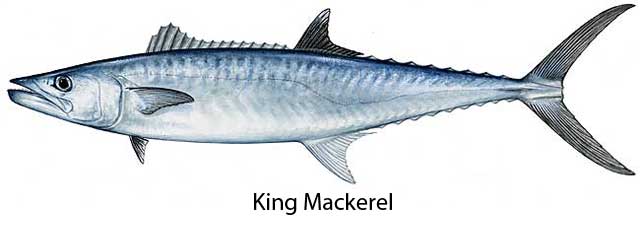
KING MACKEREL

Scomberomorus cavalla
Spanish: Sierra, Carito, Peto, Macarelas
Color of back iridescent bluish green; sides silvery, streamlined body with tapered head; no black pigment on front of dorsal fin; lateral line starts high and drops sharply below the second dorsal fin; young fish often have yellow spots like those of the Spanish mackerel.
The King Mackerel can be confused with the Cero Mackerel, Scomberomorus regalis, and the Spanish Mackerel, The unique lateral line, larger size and fewer gill rakers (6 to 10) make differentiation from these species facile.
This fish species is a pelagic carnivore that feeds primarily on crustaceans (squid and shrimp) and small schooling fishes (anchovies, menhaden, sardines, etc.). In turn it is preyed upon by dolphin, sharks and tuna.
The King Mackerel is an Atlantic Ocean only species found from the Gulf of Maine to Brazil along the Atlantic coast of the Americas in offshore waters outwards to the continental shelf. Recreational anglers catch this species year-round, however most taken in the winter and early spring.
King mackerel are constantly feeding carnivores that can attack with high speed, powerful jaws and razor-like teeth. They feed on all and any available food but favor jacks, sea trout, sardine like fishes, ribbonfish, herring, shrimp and squid.
King mackerel are a highly sought after gamefish. They are a challenging catch that puts up a spectacular fight by leaping and sky rocketing out of the water. They are taken on hook and line gear with both live or dead bait and artificial lures. They can be caught from shore or pier, from a boat at anchor, drifting or trolling. Some of the baits used are pogies, thread herring, Spanish sardine, ballyhoo, mullet, etc. Lures that have shown to be productive are spoons, jigs and other flashy sub-surface lures or large fish like plugs.